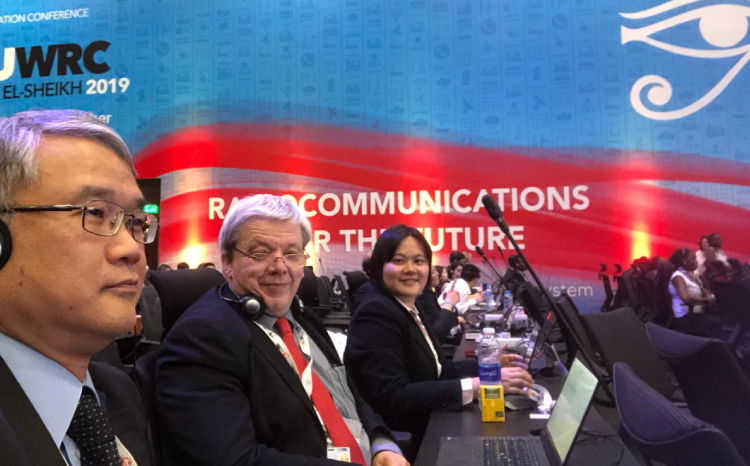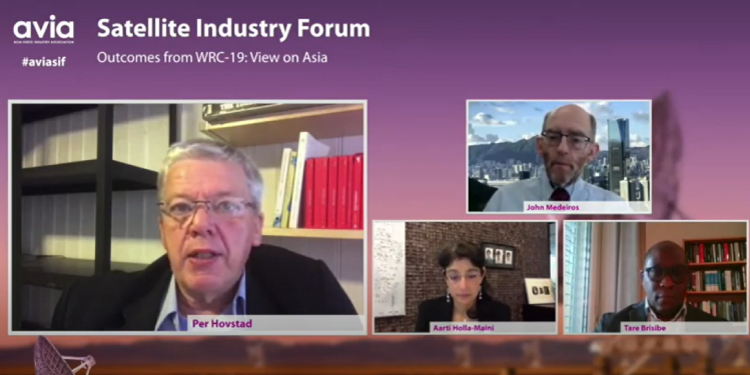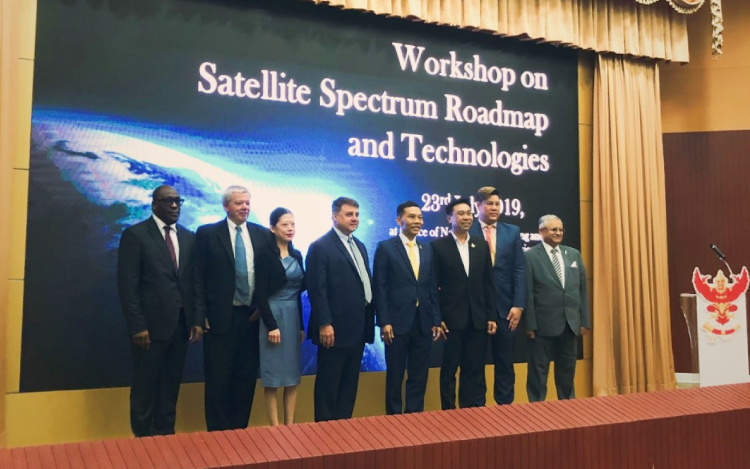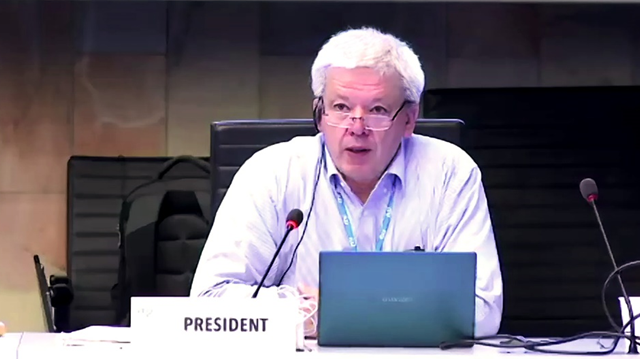Per Hovstad is AsiaSat’s Principal Spectrum Engineer. With more than 20 years of serving AsiaSat in the spectrum field, he is an active practitioner in frequency coordination and spectrum activities with satellite operators, local administrations, regional and international intergovernmental and industry associations, such as the International Telecommunication Union (ITU), Asia Pacific Telecommunity (APT) and Global Satellite Operators Association (GSOA).
At the seven last ITU World Radiocommunication Conferences (WRCs), starting at WRC-97 and during the preparatory work before the WRCs, Per has been an active contributor and has chaired various working groups on technical and satellite regulatory matters as well as studies on issues impacting satellite services. He is currently the Vice-Chair of the ITU-R (Note 1) Working Party 4A (WP 4A) and Chair of Working Group 5B-5 of ITU-R WP 5B which is addressing satellite matters in relation with aeronautical and maritime communications and in particular developing a regulatory framework for the use of regular Fixed-Satellite Service (FSS) satellites to control unmanned aircraft. Furthermore, he has assumed the additional role of representing AsiaSat at GSOA’s ITU Working Group and Regulatory Working Group besides working with Asia Video Industry Association (AVIA), Asia Satellite Coalition (ASC) and SatCom Industry Association of India (SIA-India); which AsiaSat is a member with.
During this interview, Per shares his thoughts and experience through these years dedicated to facilitating the more efficient utilisation of spectrum resources and safeguarding satellite’s ongoing access to spectrum, free of harmful interference and in a regulatory environment that gives room for future development and deployment of satellite applications and services.
Per, how would you describe your continued chairmanship role with some of the ITU’s working groups? Do you find it interesting?
I am honoured to be given the trust by the ITU-R membership to chair groups handling various satellite related matters during the study cycle between WRCs as well as at the WRCs themselves. Being part of the continuous evolution of the international regulatory framework for use of limited spectrum resources is most fascinating, despite the many challenges, for example, how to balance the interests of various stakeholders and their spectrum needs. In this work, I never cease to be impressed by the great degree of respect shown in the discussions and in constructively seeking compromise solutions which take into account the needs of the various parties. What I also find fascinating and a good proof of the ITU-R members’ capabilities in finding compromise solutions is that decisions at WRCs are made by consensus, not through votes. Over all my seven WRCs, from 1997 and up till now, I think I have only seen one single case being brought to a vote.
As a Chair, it is my job to help to coordinate and develop a common understanding of a given topic and thereafter develop solutions by identifying common ground to meet the interests of all parties to the greatest extent possible and seek the best possible compromises in cases where all interests cannot be fully met.
Can you tell us a bit more about these working groups and how they work to achieve their goals and what are the challenges behind it?
The WRCs take place approximately every four years and are sometimes referred to as the Olympic Games of the radio spectrum world. One important task of a WRC is to determine the agenda for the next WRC. Then, in the period between one WRC and the next, the different ITU-R Working Parties will be given agenda items to be studied in preparation for the coming WRC. The Working Parties will submit the results of their technical and regulatory studies, including possible solutions, in a report to the WRC which is collated by the Conference Preparatory Meeting (CPM), the CPM Report. The WRC will then, based on the CPM Report and proposals from countries and regional organisations (e.g. the APT in APAC), discuss the matter and make decisions. At the last day of the WRC, there will be a revised radio regulatory regime, contained in the revised Radio Regulations which all countries will commit to adhere to by, at the closing of the WRC, signing the Final Acts of the WRC.
ITU-R is divided into six study groups (SG) which each is further divided into several working parties (WP). For special tasks, special task groups may be set up and such task groups may also reach across several study groups. Out of these study groups, Study Group 4 is responsible for satellite services while Study Group 5 is responsible for terrestrial services. Within these study groups, in preparation for the WRC-23 to be held in Dubai on 20 November to 15 December 2023, I am in particular involved in the work of WP 4A and 5B.
WP 4A is specialised in addressing regulatory and spectrum issues related to FSS and Broadcasting-Satellite Service (BSS). It is the leading and responsible group within ITU-R for the preparatory work for WRC-23 in respect of agenda items where FSS or BSS is seeking changes to the Radio Regulations and is the “contributing” group in respect of agenda items where other services are seeking changes that might affect FSS or BSS. Being a Vice Chair for WP 4A, Chair for one of the two working groups under WP 4A and often chairing various sub-working groups and drafting groups, I am privileged to get a very good insight into the many issues related to satellite matters. One agenda item that I have been much involved in over the years is Agenda Item 7. This is a standing agenda item at every WRC and is addressing ways to remove deficiencies and improve the regulatory provisions for satellite networks. Under this agenda item, many new ideas for improvement have been introduced and significant changes have been made.
WP 5B is responsible for issues related to aeronautical and maritime mobile services and radiodetermination services (radars and radio navigation). My reason for attending this WP is that it is identified as responsible for WRC-23 Agenda Item 1.8 which is looking at possible regulatory and technical provisions for the use of Ku- and Ka-band links on regular FSS satellites to control unmanned aircraft. In the Working Group 5B-5 which I am chairing, we’re responsible for satellite related issues in WP 5B, and Agenda Item 1.8 takes up most of our time.
In the preparatory work during a study cycle, intergovernmental groups, like the APT, normally conduct their studies in parallel and sometimes make contributions to the working party meetings. More importantly, they coordinate and harmonise the efforts of the region and develop common proposals for the WRC. In making its decisions, in addition to the report from the ITU-R working parties, these common proposals from the regional groups play an important role.

The last WRC-19 was described as a success for the satellite industry as decisions made at the Conference mostly worked towards ensuring the integrity of use of the radio spectrum presently used by the satellite industry. What do you see as the main challenges ahead?
Radio spectrum is a limited resource and different uses of the same frequency band may be technically incompatible. As spectrum use is increasing, pressure on access to these scarce resources intensifies. Specifically, over the last couple of decades, the discussions have been hard in respect of spectrum access for terrestrial services in satellite bands, difficulties associated with congestion in the geostationary arc and challenges related to guaranteeing a realistic future access to geostationary orbit spectrum resources to all countries in the “Planned bands” while at the same time allowing efficient and economic use of these bands for actual satellites. In addition, with the renewed interest for non-geostationary satellites, mostly low earth orbiting satellites, I would presume that obtaining compatibility between the many non-geostationary satellite systems will be a challenge.
In the Radio Regulations, many frequency bands are allocated to several services. This does not mean that all these services are technically compatible if they are implemented in the same geographic area. With the ever increasing demand for wireless data connections with higher and higher data rates, we are seeing terrestrial applications moving up in frequency and looking for the required bandwidths in the FSS frequency bands. What’s drawing the most attention is the spectrum requirements of the International Mobile Telecommunications (IMT) systems, often referred to as 5G. In relation with FSS, the sought move into especially C- and Ka-band have and are causing a lot of challenges to the satellite industry in retaining the ability to use these key bands efficiently and economically for FSS satellite networks, while recognising that terrestrial services, and maybe in particular IMT/5G do have requirements for spectrum to offer higher data rates and more applications. I think the technical difficulties associated with co-existence in the satellite downlink bands are well known to everybody by now, however one has not been equally good in distinguishing between the different technical challenges and opportunities associated with co-existence in satellite downlink and uplink bands.
There are now more than 500 geostationary satellites in orbit. Several of these operate in the most commonly used C- and Ku- FSS bands and increasingly in Ka-band. As a result, one now sees satellites very closely spaced along the geostationary arc, making it very difficult to find space for a new satellite. This task is made even more difficult as very conservative ITU-R criteria are used to trigger coordination, i.e. when a newcomer needs to seek the agreement in respect of a filing for an incumbent satellite network. The ITU-R procedures are such that priority is given at the time of making a claim/request for a given orbit location (by submitting a filing to ITU-R). There are no limitations as to how many such filings a country can submit. Noting the congestion of satellites in the geostationary arc, succeeding to coordinate a given location has become very uncertain. To increase the chances of succeeding to coordinate one orbital location, it is therefore common to submit filings for multiple orbital locations (these are often referred to as “paper satellites”). This in turn makes it even harder for those coming after to coordinate and find a place for their satellite networks. Finding ways to accommodate as many satellite networks as possible while at the same time offering adequate protection for realistic operation of incumbent satellite networks is and will remain a big challenge.
Already in the 1970s, concerns were expressed that all orbit spectrum resources would be taken and that those countries having no satellites would have no place and no spectrum if and when they might want to launch a satellite in the future. In response to this, ITU-R established the “Planned bands” wherein each and every country in the world is given a hypothetic satellite with defined characteristics (orbital location, frequency band, EIRP, national coverage, earth stations, etc.) in the “Space Plans”. For APAC, the spectrum identified for these “Space Plans” amount to 300 MHz up/down in C-band and 1 GHz up/down in Ku-band. Any satellite network wanting to use these bands, in addition to protecting and getting the agreement of all other satellites using these bands, also needs to protect and obtain the agreement of all those countries whose hypothetical satellite is considered as affected.
Satellites are expensive, and in order to be economically viable, satellites in many cases need to sell services in several countries. As a result, some countries will have satellite operators located in their country with satellites covering multiple countries, while other will not. The limitation to national coverage of the hypothetical satellites in the “Plans” would make it difficult for most countries to build and operate a satellite network in accordance with the “Plan” in an economical manner. At the same time, due to the dire lack of orbit spectrum resources, much of the capacity outside that in the “Space Plans” is already taken by satellites for “additional use”. This means that it is very difficult, if not impossible, for countries to expand what they have in the “Plan” to coordinate and launch a satellite that could be operated in a cost efficient manner.
This has become a political hot potato in ITU-R and is by many portrayed as a developing vs. developed country problem, but I believe it is more correct to say that this is an issue between those countries that have satellites and those that don’t. Striking the right balance between guaranteed access for those that don’t have satellites and economic and efficient use of 1.3 GHz of prime satellite band is an ever ongoing process in ITU-R and the source of many a heated debate. One thing to bear in mind is that the “Planned bands” are also allocated by ITU-R for terrestrial services and as we know, they also have growing spectrum needs. It would be naïve to believe that if no satellites were to use the bands, the terrestrial services would meekly sit and observe all this unused spectrum. Use of the bands by satellites therefore offers protection against terrestrial services, also for the countries having just their space in the “Plans”.
Our objective is to continue our efforts to protect the satellite industry’s continued access to essential radio spectrum and to decide on the regulatory conditions that would facilitate the development of future generation satellite networks, and the long-term viability and sustainability of the satellite industry.

In your opinion, what would be the focus/highlights for next year’s WRC-23?
I think several agenda items of relevance to the satellite industry would raise a lot of debate.
For example, Agenda Items 1.2 and 1.3, which are in different ways addressing the use of, amongst others, 3.6-3.8 GHz for mobile communications and IMT/5G. At face value, these agenda items do not address APAC in this frequency band, but noting that ITU-R has already allocated this frequency band for mobile use in APAC, it is evident that any decisions to facilitate IMT/5G in other regions will lead to pressure to introduce IMT/5G in APAC countries as well. It is also worth noting that IMT/5G is already being introduced in this band in countries outside APAC, e.g. the European Union. Depending on the outcome, these agenda items could mark the onset of a battle to defend FSS, not only against IMT/5G in 3.4-3.6 GHz, but also in 3.6-3.8 GHz.
Agenda Items 1.15 and 1.16 are addressing use of mobile terminals communicating with FSS satellites for geostationary satellites in Ku-band and non-geostationary satellites in Ka-band respectively. These are good applications where FSS satellites have proved very effective over the years. However, from a regulatory perspective, there are several challenges and fierce debates are expected. One must only hope that in the end, a good solution is found for a regulatory regime that allows efficient operation of such applications.
Agenda Item 1.8 is addressing the use of regular geostationary Ku- and Ka-band FSS satellites to control unmanned aircraft. This is somewhat related to Agenda Items 1.15 and 1.16 through the use of mobile terminals. However, there is complication that control of aircraft is regulated by ICAO (International Civil Aviation Organisation) and they have a need to ensure a safe flight. How to enable such operation within the framework of regular FSS and without posing any additional constraints or limitations on other regular FSS, will be a challenge.
Agenda Item 7 is yet another agenda item where we see several topics that are likely to raise serious discussions. Under this standing agenda item for WRC-23, we see many proposals related to the “Planned bands” with an aim to preserve and prioritise these frequency bands for countries with no satellites and new ITU-R member countries (e.g. the new countries from the old Yugoslavia). Measures to this effect could easily disadvantage actual satellite operation and efficient use of these frequency bands. Again, one must only hope that decisions will not lead to a situation where realistic satellite operation is no longer possible.
AsiaSat has joined the ITU Working Group and Regulatory Working Group of GSOA, how are these initiatives related to your preparatory work for WRC-23?
The GSOA provides a platform for satellite operators around the world to work together in a coordinated way that allows for sharing our experiences across different regions to support the satellite industry as a whole. We are excited to be part of the GSOA efforts, working closely with individual governments and telecommunications regulators on spectrum allocations and access, following WRC decisions and within the Radio Regulations in force, to ensure that satellite can continue to play an indispensable role in providing the needed connectivity to all corners of the world.
In addition, we are also working actively with various regional industry groups to coordinate our efforts in defending the interests of the satellite industry with a particular regional focus. These include AVIA, ASC and SIA-India.
I believe the global focus and the expertise within GSOA in close collaboration with these regional groups provide a powerful combination that supports us in our work with regulators in respect of spectrum allocation and licensing issues, e.g. through responding to consultations or in direct contact with the regulator.
Although the main focus of GSOA and the regional groups is to work directly with individual regulators in respect of their national legislation within the regulatory framework of the Radio Regulations in force at any given time, these groups also offer an opportunity for satellite operators to exchange thoughts and views on agenda items for upcoming WRCs and develop harmonised views on these. Such coordination provides good support for satellite operators when working with the views of their respective regulators on WRC agenda items and in work within the ITU-R working parties as well as in the regional intergovernmental organisations, such as APT in the case of APAC.
Note 1: ITU is a specialised agency of the United Nations where ITU-R is the Radiocommunication Sector of ITU.
Read the white paper on “Controlling Unmanned Aircraft Through Regular Commercial FSS Transponders. Good or Bad Idea?” recently published by Per to explore the feasibility of using regular geostationary Ku- and Ka-band FSS satellites to control unmanned aircraft.

